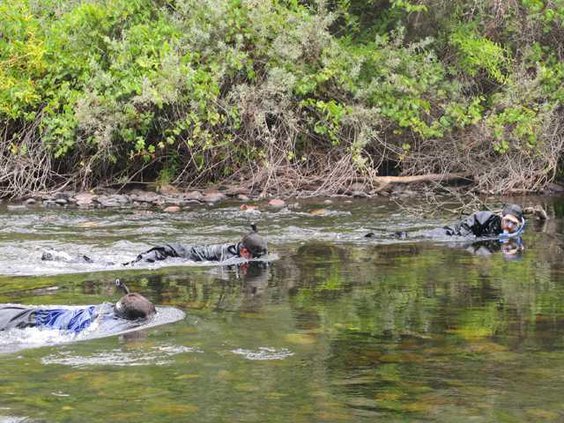Sacramento bureaucrats want cities and farms that rely on water from the Stanislaus, Tuolumne and Merced rivers to pay a steep price in a bid to set aside more water for fish.
The state Water Resource Control Board after spending $70 million and devoting 10 years to come up with a proposal without conducting a single public meeting in the affected counties of San Joaquin, Stanislaus, and Merced wants to nearly double the unimpaired flows for fish in the three rivers to 40 percent. That represents a loss of 350,000 acre feet or enough water to meet the annual needs of a million California families.
The Modesto Irrigation District points to independent studies that project such a move will cost the three-county 209 region 6,756 jobs and annual losses of $1.6 billion.
Even so, the strategy that the state embraced on thursday in a bid to benefit struggling salmon is likely to backfire, according to South San Joaquin Irrigation District General Manager Pete Rietkerk.
“We have science on the Stanislaus that shows it (what the state proposes) won’t help the fish,” Rietkerk said.
He added it is likely to do the opposite and further stress the endangered Chinook salmon.
SSJID and Oakdale Irrigation District have been spending $1 million on an annual basis for more than 10 years to secure expertise of FISHBIO scientists, biologists, and technicians to monitor fish and river conditions as well as to work toward creating more spawning habitats. OID has invested $1.1 million in a project at Honolulu Bar that was completed in 2012 to restore spawning habitat and create a safe haven for juvenile restoring spawning ground on the river as well. The state during the same time period spent $70 million to prepare their response without colleting any such data on salmon in the Stanislaus.
The SSJID/OID studies show that releasing too much water in the spring – especially during a drought – diminishes the cold water stored in upstream reservoirs that trout need to successfully spawn later in the year. The state’s plan ignores more than two decades of scientific research on the river that Rietkerk noted clearly shows more water does not equal more fish.
The districts used that to rally against a plan that would have released more water for the fish earlier in the season and not leave enough “cold water pool” behind New Melones for the critical summer and fall period when water temperatures rise.
Such a strategy, the districts argued, would essentially have fried the fish.
The research also seems to verify a 2014 study by the state Department of Water Resources that 95 percent of young salmon and steelhead are eaten by predators such as bass before reaching the Delta.
To that end, research points to a need to address predators that lurk in deep pools between Riverbank and the Stanislaus’ confluence with the San Joaquin River.
The state’s move is being described by some water experts as “one of the most significant overhauls of water allocation this century in California.”
Rietkerk noted that the state intends to take water from those with senior and superior adjudicated water rights extending back to the 19th century to implement their plans.
Had the proposed increase in water flows been in place in 2015, there would have been major cutbacks to the SSJID delivery water to farms and the cities of Manteca, Lathrop, and Tracy on top of the 20 percent reduction already in place due to the drought.
“The State Water Board needs to rethink its plan. We again request that state officials engage in constructive public discussions to modify the proposal and to identify ways to mitigate the significant impacts identified in their plan,” Rietkerk said. “We ask the state to extend its 45-day public comment period to at least 90 days so that farmers and others involved in agriculture’s ongoing harvest have time to analyze and participate in developing responses to the impacts of the plan. We also ask the SWB to hold public hearings in San Joaquin, Stanislaus and Merced counties so that the locally affected residents can be heard and have their input seriously considered.”
Rietkerk made it clear the SSJID intends to vigorously defend its legally adjudicated senior water rights.
The Modesto and Turlock irrigation districts have launched an awareness campaign dubbed “Worth Your Fight” to help residents in the region as well as their customers to “understand the significance of the State Water Board’s attempt to steal their livelihood.”
They have jointly established a website at WorthYourFight.org to address the issue.
Proposal applies
only to Lower
San Joaquin River
The draft proposal applies to the lower San Joaquin River, three of its tributaries and the southern end of the San Joaquin delta with the Sacramento River.
The delta is part of the largest estuary on the West Coast, home to dozens of threatened native species and a water source for two-thirds of California’s 39 million people and millions of acres of farm land.
Long stretches of the upper San Joaquin River have been dry for decades because of heavy pumping. Salmon populations have survived in the drought only because of intervention by wildlife agencies, which raise the young salmon in hatcheries and carry them in trucks past dry stretches of the river.
The proposal by regulators calls for leaving 30 percent to 50 percent of normal flows in the river system, with 40 percent as a benchmark.
While reducing the amount of water available for farms, increased river flows would benefit farmers and city dwellers by reducing salinity in water and sweeping away some of the algae blooms plaguing California waterways, said Les Grober, a state water-right official.
John McManus, executive director of the Golden Gate Salmon Association fishing group, said leaving more water in the river would also benefit people by making salmon catches more plentiful.
The Associated Press contributed to this story.
MASSIVE WATER GRAB
State: Sacrifice 6,756 jobs, fallow 240,000 acres in 209 for fish





